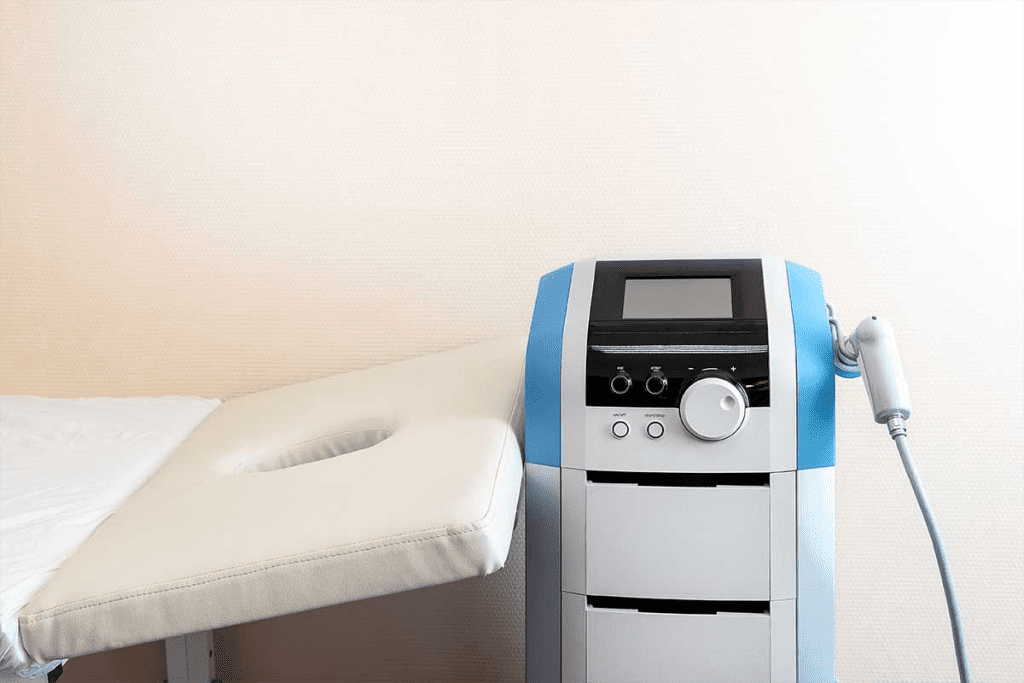Last Updated on October 31, 2025 by
A lithotripsy procedure is a noninvasive treatment that lasts 30 to 60 minutes. It uses shock waves to break up kidney stones. These stones then become small enough to pass through the urinary system.

For those with large kidney stones, lithotripsy is a quick fix. Top hospitals like Liv Hospital use new methods to make sure patients get the best care. They aim to make the experience as good as it can be.
ESWL is a new way to help people pass kidney stones without surgery. It’s a non-invasive treatment that has changed kidney stone treatments. It’s a less invasive option compared to old surgical methods.

Extracorporeal Shock Wave Lithotripsy (ESWL) is a medical procedure. It uses shock waves to break up stones in the kidney, bladder, or ureter. The purpose of ESWL is to make these stones smaller. This way, they can be easily passed out in urine, relieving pain and obstruction.
The procedure uses a lithotripter machine to create shock waves. These waves are aimed at the stone using X-ray or ultrasound. This ensures the stone is hit precisely, with little damage to nearby tissue.
ESWL works well for many types of kidney stones. It’s good for calcium oxalate, uric acid, and cystine stones. Whether ESWL is right for you depends on the stone’s size, location, and type, and your overall health.
Knowing about the types of kidney stones and their characteristics is key. It helps decide the best treatment plan, including whether ESWL is right for you.
Many patients ask how long a lithotripsy procedure takes. It usually lasts about 30 to 60 minutes. This time can change based on the stone’s size, where it is, and the patient’s health.

A lithotripsy session is usually 30 to 60 minutes long. During this time, the machine sends shock waves to break the stone into smaller pieces. These pieces can then be easily passed out of the body. The number of shock waves used is between 1,000 and 3,000.
“The lithotripsy procedure is a highly effective treatment for kidney stones, with a quick recovery and low risk of complications,” says a leading urologist. The machine’s precision helps target the stone without harming nearby tissue.
Several things can affect how long a lithotripsy session takes. The stone’s size and where it is matter a lot. Larger stones or those in hard-to-reach spots need more time and shock waves. Also, the patient’s body type and health can influence the time needed.
Lithotripsy is often done on an outpatient basis, so patients can go home the same day. The time for outpatient procedures is usually the same as for inpatient ones. But, outpatient procedures might be quicker because of shorter preparation and recovery times.
In summary, while the actual procedure lasts 30 to 60 minutes, the total time at the hospital can vary. The stone’s size, location, and the patient’s health are key factors in determining the treatment’s duration.
It’s important for patients to know about the lithotripsy process. This treatment has several key phases. Each phase is vital for treating kidney stones successfully.
Preparation before the treatment is a key step. It includes giving kidney stone medication to ease symptoms or prevent infection. Patients are usually told not to eat or drink for a while before the procedure.
This phase also involves placing the patient on the treatment table. Imaging technologies are used to find the kidney stone accurately.
Anesthesia administration is a critical phase. The type of anesthesia used can vary. It depends on the patient’s condition and the procedure’s complexity.
This period is short. The patient is closely watched to ensure their comfort and safety.
This is when shock waves are sent to the kidney stone. It’s the heart of the lithotripsy process. The stone is broken down into smaller pieces that can be easily passed out.
The length of this phase varies. It depends on the stone’s size, location, and the patient’s response to treatment.
After the treatment, the patient is monitored closely. This is to check for any immediate complications or reactions. It’s important for the patient’s safety and comfort.
The lithotripsy process includes preparation, anesthesia, treatment, and monitoring. It’s designed to treat kidney stones safely and effectively.
After lithotripsy, your body works hard to get rid of the stone pieces. Knowing what to expect can make recovery easier.
In the first 24 hours, rest and drink lots of water. Some pain is normal and can be treated with medicine. You might see blood in your urine, but it usually goes away.
It may take weeks to pass the stone pieces. Keep drinking lots of water. You might feel sharp pains as the pieces move.
You can usually go back to normal in a few days to a week. But it depends on the stone size, location, and your health. Avoid heavy lifting or hard activities at first.
Knowing the recovery timeline helps you prepare for what comes next. It makes it easier to deal with passing the stone pieces and getting back to your routine.
Lithotripsy is a common treatment for kidney stones. Its success rates are key to its effectiveness. The goal is to break the stone into small pieces that can pass easily.
The first time lithotripsy is done, it works for about 65-67% of patients. This means about two-thirds of people have their stones broken up after the first try. The success depends on the stone’s size, where it is, and the patient’s health.
If more sessions are needed, they are usually 4-6 weeks apart. This time, let the body pass the stone pieces and decide if more treatment is needed.
With more sessions, lithotripsy gets even better. By the third time, the success rate jumps to over 90%. This shows most people can clear their stones with a few treatments.
In summary, lithotripsy is a good choice for kidney stones, getting better with each session. Other options include ureteroscopy, percutaneous nephrolithotomy, and open surgery. These are the 4 methods for kidney stone removal available.
Lithotripsy is a safe and effective way to treat kidney stones. It has high success rates and few complications. Patients can make a smart choice by learning about it.
The treatment lasts from 30 to 60 minutes. It includes getting ready, getting anesthesia, the treatment itself, and watching over you right after.
It works well for many people, with a 65-67% success rate in the first session. By the third session, it reaches a 90% success rate. Talking to a doctor can help decide if lithotripsy is right for you.
Understanding the benefits and risks of lithotripsy helps you make a choice. This way, you can take charge of your treatment for kidney stones.
Lithotripsy is a noninvasive treatment. It uses shock waves to break up kidney stones. These smaller pieces can then pass through the urinary system.
A lithotripsy procedure usually lasts between 30 and 60 minutes.
ESWL can treat many types of kidney stones. This includes stones made of calcium oxalate, uric acid, and others.
Several factors can affect the procedure’s length. These include the stone’s size and location, the patient’s health, and the techniques used.
Lithotripsy is often done on an outpatient basis. But sometimes, it may require a short hospital stay.
After lithotripsy, patients might feel some discomfort or pain. They are advised to drink plenty of fluids to help pass the stone fragments.
The time it takes to pass the stones can vary. Staying hydrated is key to helping pass the fragments.
Lithotripsy’s success rate is about 65-67% after the first session. It can reach around 90% by the third session.
Sometimes, more than one session is needed. The time between sessions can differ.
The time to return to normal activities varies. Patients are usually advised to avoid strenuous activities for a short time.
Kidney stones can be painful and serious if not treated. But lithotripsy is a safe and effective treatment.
Lithotripsy is one method for removing kidney stones. Other options include surgical procedures or medication.
Subscribe to our e-newsletter to stay informed about the latest innovations in the world of health and exclusive offers!